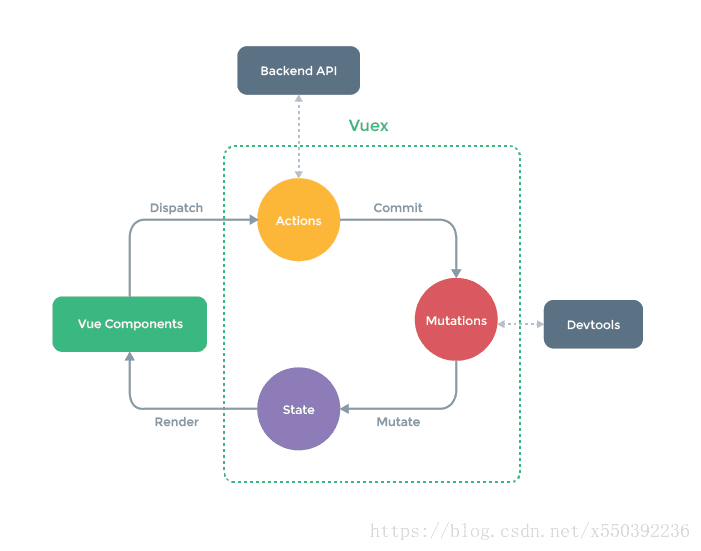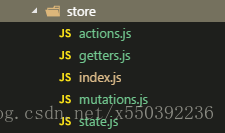Vuex总体案例详解
作者:猫老板的豆

一、简介
我们来看看对 Vuex 比较专业的介绍:
Vuex 是一个专为 Vue 开发的应用程序的状态管理模式,它采用集中式存储管理应用的所有组件的状态,并以相应的规则保证状态以一种可预测的方式发生变化。
简而言之,Vuex 采用类似全局对象的形式来管理所有组件的公用数据,如果想修改这个全局对象的数据,得按照Vuex提供的方式来修改(不能自己随意用自己的方式来修改)。
二、优点
Vuex状态管理跟使用传统全局变量的不同之处:
- Vuex的状态存储是响应式的: 就是当你的组件使用到了这个 Vuex 的状态,一旦它改变了,所有关联的组件都会自动更新相对应的数据,这样开发者省事很多。
- 不能直接修改Vuex的状态: 如果是个全局对象变量,要修改很容易,但是在 Vuex 中不能这样做,想修改就得使用 Vuex 提供的唯一途径:显示地提交(
commint)mutations来实现修改。这样做的好处就是方便我们跟踪每一个状态的变化,在开发过程中调试的时候,非常实用。
三、使用步骤
1. 安装Vuex
npm install vuex --save
2. 引用Vuex
import Vue from 'vue' import Vuex from 'vuex' Vue.use(Vuex)
3. 创建仓库Store
要使用 Vuex,我们要创建一个实例 store,我们称之为仓库,利用这个仓库 store 来对我们的状态进行管理。
//创建一个 store
const store = new Vuex.Store({});
四、包含模块
- State:定义了应用状态的数据结构,可以在这里设置默认的初始状态。
- Getter:允许组件从 store 中获取数据,
mapGetters辅助函数仅仅是将 store 中的getter映射到局部计算属性。 - Mutation:是唯一更改 store 中状态的方法,且必须是同步函数。
- Action:用于提交
mutation,而不是直接变更状态,可以包含任意异步操作。 - Module:可以将 store 分割成模块(module)。每个模块拥有自己的
state、mutation、action、getter、甚至是嵌套子模块
Vuex的作用类似全局对象,Vuex 使用单一状态树,用一个对象State包含了整个应用层级的所有状态,你可以理解为这些状态就是一堆全局变量和数据。

1. State
假设我们有一个全局状态 count 的值为 5。那么,我们就可以将其定义为 state 对象中的 key 和 value,作为全局状态供我们使用。如下:
//创建一个 store
const store = new Vuex.Store({
//state存储应用层的状态
state:{
count:5 //总数:5
}
});
2. Getters
可以认为,getters 是store的计算属性,类似于computed,对state里的数据进行一些过滤,改造等等
假设我们要在state.count的基础上派生出一个新的状态newCount出来,就适合使用我们的 getters
getters 接受 state 作为其第一个参数
const store = new Vuex.Store({
//state存储应用层的状态
state:{
count:5 //总数:5
},
getters:{
newCount:state => state.count * 3
}
});
在组件中获取 {{newCount}} 方式:
export default {
computed: {
newCount(){
return this.$store.getters.newCount;
}
}
};
3. Mutations
Vuex 给我们提供修改仓库 store中的状态的唯一办法就是通过提交mutation ,且必须是同步函数
我们在 mutations中定义了一个叫increment的函数,函数体就是我们要进行更改的地方
会接受 state作为第一个参数,第二个是自定义传参
const store = new Vuex.Store({
//state存储应用层的状态
state:{
count:5 //总数:5
},
// mutations是修改state中数据的唯一途径
mutations:{
increment(state,value){
state.count += value;
}
}
});
我们在提交commit时候,第一个参数"increment",就是对应在 mutations中的increment方法,第二个参数是自定义值。例如:
methods: {
getVal(event) {
//获取当前的按键的值
let value = event.target.dataset.value;
//通过commit提交一个名为increment的mutation
this.$store.commit("increment", value);
}
}
在组件中获取 {{count}} 方式:
export default {
computed: {
count(){
return this.$store.state.count;
}
}
};
4. Action
- 用于提交
mutation,而不是直接变更状态,可以包含任意异步操作 - 只有通过
action=>mutations=>states,这个流程进行操作,具体步骤如下:
export default new Vuex.Store({
//存放数据
state: {
obj: {},
},
//4. 通过commit mutations中的方法来处理
mutations: {
getParam(state, Object) {
//5.修改state中的数据
state.obj = Object
}
},
//2.接受dispatch传递过来的方法和参数
actions: {
getParamSync(store, Object) {
// 处理异步操作
setTimeout(() => {
//3.通过commit提交一个名为getParam的mutation
//action 函数接收一个 store 的实例对象,因此你可以调用 store.commit 提交一个 mutation
store.commit('getParam', Object);
}, 1000)
}
}
})
然后我们就在组件里这么调用就可以了
methods: {
getVal() {
let name= 'xia';
let age= '26';
let sex= 'man';
//1.通过dispatch将方法getParamSync和多个参数{name,age,sex}传递给actions
this.$store.dispatch('getParamSync',{name,age,sex})
}
}
5. Modules
随着项目的复杂度增大,为了方便管理 Vuex,一般会将其按功能分割成不同的模块(Module),方便日后管理。每个模块拥有自己的 state、mutation、action、getter 甚至是嵌套子模块
import Vue from 'vue'
import Vuex from 'vuex'
import state from './state'
import mutations from './mutations'
import actions from './actions'
import * as getters from './getters'
import moduleA from './module/moduleA' // 模块A
import moduleB from './module/moduleB' // 模块B
Vue.use(Vuex)
export default new Vuex.Store({
actions,
getters,
state,
mutations,
modules: {
moduleA,
moduleB
}
})
moduleA.js / moduleB.js 文件
// 每个模块拥有自己的 state、mutation、action、getter、甚至是嵌套子模块
export default {
state: {
text: 'moduleA'
},
getters: {},
mutations: {},
actions: {}
}
然后我们就在组件里这么调用就可以了
<template>
<div class="demo">
<h1>{{getText1}}</h1>
<h1>{{getText2}}</h1>
</div>
</template>
computed: {
getText1(){
return this.$store.state.moduleA.text;
},
//或
...mapState({
getText2: state => state.moduleB.text;
})
}
由此可知,模块内部的 state 是局部的,只属于模块本身所有,所以外部必须通过对应的模块名进行访问。
五、Vuex最最简单的项目实例
运用vuex语法糖mapMutations和mapGetters
1. 存储数据
a.vue 文件
import { mapMutations } from "vuex"; // 引入mapMutations
export default {
methods: {
...mapMutations({
// 将changeNews与mutations中的SET_NEWS关联
changeNews: "SET_NEWS"
}),
submit(){
// 提交一个名为changeNews的mutation,并传入参数val
let val = 'test news';
this.changeNews(val);// 相当于this.$store.commit("changeNews", val);
}
}
}
2. 获取数据
b.vue 文件
import { mapGetters } from "vuex"; // 引入mapGetters
export default {
computed: {
// 用vuex读取数据(读取的是getters.js中的数据)
// 相当于this.$store.getters.news(vuex语法糖)
...mapGetters(["news"])
},
created() {
// 获取getters中news数据
console.log(this.news);
}
}
3. store文件目录结构

index.js
import Vue from 'vue'
import Vuex from 'vuex'
import state from './state'
import mutations from './mutations'
import actions from './actions'
import * as getters from './getters'
//每次修改state都会在控制台打印log
import createLogger from 'vuex/dist/logger'
Vue.use(Vuex)
const debug = process.env.NODE_ENV !== 'production'
export default new Vuex.Store({
actions,
getters,
state,
mutations,
strict: debug, // 当debug=true时开启严格模式(性能有损耗)
plugins: debug ? [createLogger()] : []
})
state.js
const state = {
news: {}
}
export default state;
mutations.js
const mutations = {
SET_NEWS(state, val) {
state.news= val
}
}
export default mutations;
actions.js
//异步处理
const actions = {
M_NEWS({ commit }, val) {
commit('SET_NEWS', val); // commit mutations修改
}
}
export default actions;
getters.js
// 通常通过getters取数据 (this.$store.getters.news;) export const news = state => state.news // 不做其他处理 直接映射出去
4. 使用store
在 main.js 中引用
import store from './store' //vuex存储文件
new Vue({
el: '#app',
router,
store,
components: {
App
},
template: '<App/>'
})
到此这篇关于Vuex总体案例详解的文章就介绍到这了,更多相关Vuex总体内容请搜索脚本之家以前的文章或继续浏览下面的相关文章希望大家以后多多支持脚本之家!
